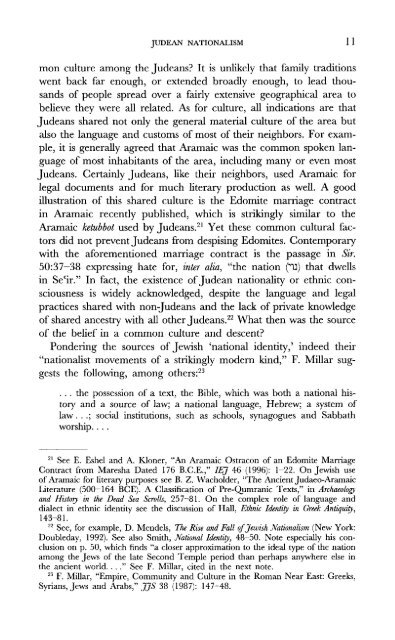historical perspectives: from the hasmoneans to bar kokhba in light ...
historical perspectives: from the hasmoneans to bar kokhba in light ...
historical perspectives: from the hasmoneans to bar kokhba in light ...
Create successful ePaper yourself
Turn your PDF publications into a flip-book with our unique Google optimized e-Paper software.
JUDEAN NATIONALISM 1 1<br />
rnon culture among <strong>the</strong> Judeans? It is unlikely that family traditions<br />
went back far enough, or extended broadly enough, <strong>to</strong> lead thousands<br />
of people spread over a fairly extensive geographical area <strong>to</strong><br />
believe <strong>the</strong>y were all related. As for culture, all <strong>in</strong>dications are that<br />
Judeans shared not only <strong>the</strong> general material culture of <strong>the</strong> area but<br />
also <strong>the</strong> language and cus<strong>to</strong>ms of most of <strong>the</strong>ir neighbors. For example,<br />
it is generally agreed that Aramaic was <strong>the</strong> common spoken language<br />
of most <strong>in</strong>habitants of <strong>the</strong> area, <strong>in</strong>clud<strong>in</strong>g many or even most<br />
Judeans. Certa<strong>in</strong>ly Judeans, like <strong>the</strong>ir neighbors, used Aramaic for<br />
legal documents and for much literary production as well. A good<br />
illustration of this shared culture is <strong>the</strong> Edomite marriage contract<br />
<strong>in</strong> Aramaic recently published, which is strik<strong>in</strong>gly similar <strong>to</strong> <strong>the</strong><br />
Aramaic ketubbot used by Judeans. 21 Yet <strong>the</strong>se common cultural fac<strong>to</strong>rs<br />
did not prevent Judeans <strong>from</strong> despis<strong>in</strong>g Edomites. Contemporary<br />
with <strong>the</strong> aforementioned marriage contract is <strong>the</strong> passage <strong>in</strong> Sir.<br />
50:37-38 express<strong>in</strong>g hate for, <strong>in</strong>ter alia, "<strong>the</strong> nation ( ) that dwells<br />
<strong>in</strong> Se ir." In fact, <strong>the</strong> existence of Judean nationality or ethnic consciousness<br />
is widely acknowledged, despite <strong>the</strong> language and legal<br />
practices shared with non-Judeans and <strong>the</strong> lack of private knowledge<br />
of shared ancestry with all o<strong>the</strong>r Judeans. 22 What <strong>the</strong>n was <strong>the</strong> source<br />
of <strong>the</strong> belief <strong>in</strong> a common culture and descent?<br />
Ponder<strong>in</strong>g <strong>the</strong> sources of Jewish 'national identity,' <strong>in</strong>deed <strong>the</strong>ir<br />
"nationalist movements of a strik<strong>in</strong>gly modern k<strong>in</strong>d," F. Millar suggests<br />
<strong>the</strong> follow<strong>in</strong>g, among o<strong>the</strong>rs: 23<br />
. . . <strong>the</strong> possession of a text, <strong>the</strong> Bible, which was both a national his<strong>to</strong>ry<br />
and a source of law; a national language, Hebrew; a system of<br />
law . . .; social <strong>in</strong>stitutions, such as schools, synagogues and Sabbath<br />
worship. . . .<br />
21 See E. Eshel and A. Kloner, "An Aramaic Ostracon of an Edomite Marriage<br />
Contract <strong>from</strong> Maresha Dated 176 B.C.E.," IEJ 46 (1996): 1-22. On Jewish use<br />
of Aramaic for literary purposes see B. Z. Wacholder, "The Ancient Judaeo-Aramaic<br />
Literature (500-164 BCE). A Classification of Pre-Qumranic Texts," <strong>in</strong> Archaeology<br />
and His<strong>to</strong>ry <strong>in</strong> <strong>the</strong> Dead Sea Scrolls, 257—81. On <strong>the</strong> complex role of language and<br />
dialect <strong>in</strong> ethnic identity see <strong>the</strong> discussion of Hall, Ethnic Identity <strong>in</strong> Greek Antiquity,<br />
143-81.<br />
22 See, for example, D. Mendels, The Rise and Fall of Jewish Nationalism (New York:<br />
Doubleday, 1992). See also Smith, National Identity, 48-50. Note especially his conclusion<br />
on p. 50, which f<strong>in</strong>ds "a closer approximation <strong>to</strong> <strong>the</strong> ideal type of <strong>the</strong> nation<br />
among <strong>the</strong> Jews of <strong>the</strong> late Second Temple period than perhaps anywhere else <strong>in</strong><br />
<strong>the</strong> ancient world. . . ." See F. Millar, cited <strong>in</strong> <strong>the</strong> next note.<br />
23 F. Millar, "Empire, Community and Culture <strong>in</strong> <strong>the</strong> Roman Near East: Greeks,<br />
Syrians, Jews and Arabs," JJS 38 (1987): 147-48.

















